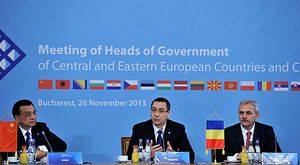The 16-plus-one concept, China’s mechanism for engaging with Central and Eastern Europe, is a puzzling one. The bloc brings together a group of European countries, some in the European Union (EU), some aiming to join (Serbia), and some most definitely outside of it and likely to stay there (Belarus). It includes stable, enthusiastic observers of EU social and political standards like Latvia and Lithuania, and then more troubled members – Hungary and Poland being the two most prominent members at present, with their resistance to some key EU current aims. Why is it that China should want to reach out to all of these countries as one cohesive block?
Granted, China’s enthusiasm over the last few years for setting up its own international network of multilateral groupings has become well known. That in part might explain it. The Shanghai Cooperation Organization (SCO) was the first, way back in the 1990s. There was was the embracing of BRICS (Brazil, Russia, India, China, and South Africa) and the setting up of a small bank to support it in Shanghai. That was followed by the Asian Infrastructure Investment Bank (AIIB). There are also ideas like the Association of Southeast Asian Nations (ASEAN) plus one, and the Australia-initiated Asia Pacific Economic Conference (APEC), where China has simply grafted itself onto something older and created something new. The list goes on.
The 16-plus-one is just the most westerly of these groupings. It was greeted with suspicion by the EU when the idea first emerged, around the time Chinese President Xi Jinping became Party secretary in 2012. But while Beijing set up a secretariat of its own for the group within the Ministry of Foreign Affairs, the 16 had no such desire to establish an office. Things therefore looked pleasantly dormant for a couple of years, a period marked by the gentle rhythm of high level summits, which came and went leaving what seemed not a mark behind.
A few recent developments, however, look set to change all of this. Some are in China’s favor; some perhaps should worry it. First, with the Belt and Road Initiative and its reach into the wider world as the core narrative of China’s global engagement, suddenly the 16 European countries have a clear idea to latch on to. Infrastructure, investment, and Chinese money might be on its way. Chinese Premier Li Keqiang was in the region earlier this year; so was Xi Jinping last year. High-level visits from China usually mean something is afoot. The hunt for Chinese money is a very real aim the 16 can embrace.
In terms of economic strategy, too, the 16-plus-one has uses. Serbia and the corridor up to Hungary are hugely important logistic lines. A high-speed rail line between Belgrade and Budapest was under discussion with Chinese funding in 2016, but has so far not proceeded. There are more opportunities for China to use its new high-speed rail technology, which is now the most advanced and experienced in the world, to build market and investment links beyond its borders. The 16-plus-one group offers one zone for this, and a key one, linking the Middle East, Russia, and Europe.
Finally, there is the simple geopolitics. This might be the most important motive but the least noted at the moment. The Belt and Road Initiative, creating a comfortable, non-contentious zone of Chinese interest right in Russia’s backyard, looks increasingly like a Chinese diplomatic masterstroke. Across a massive swath of Central Asia, Chinese investment is increasing, and political links with Beijing, rather than Moscow, are warming up. The 16-plus-one offers a very similar scenario. Many of the members are former satellites of the former Soviet Union; they fall into Russia’s natural zone of interest and influence. And yet, China for the first time ever is building a benign bamboo curtain around Russia where, decades ago, there was an iron curtain under the Soviet Union. And as with Central Asia, all that Russia can do is smile politely and bear this new phenomenon.
All is not completely rosy for China, however. There are significant risks in the 16-plus-one strategy, most notably the common problem of great expectations toward China being met with brute reality. For all the promises of investment, commentators in the region have noted that the cases of Chinese job-creating greenfield investment are few and far between. The EU and the United States remain by far the most important investors, a phenomenon that is unlikely to change for decades. And no one, least of all the Chinese with very little experience in the region, should be complacent about the ancient but currently largely dormant antagonisms in the Balkans and across the region more generally. An upsurge of destabilizing events at a time when China’s commitments to the area are too large to walk away from will create precisely the track of obligation and commitment China is so fearful of.
The 16 European countries put together to engage with China offer evidence of a new era of global China. In none of these countries, until now, has China ever appeared significant. They lived under different geopolitical umbrellas and within a different context. But in the second decade of the 21st century, this diverse grouping, with so many differences between the members, is united by a common desire to get more from the opportunities coming from China. Optimism is thick in the air; the 16-plus-one summits are popular events. The issue, however, as elsewhere, is that while the expectations toward China are diverse, disappointment often takes an eerily similar form. For China, ensuring that it fulfills some of the hopes expressed toward it will be very important.

































